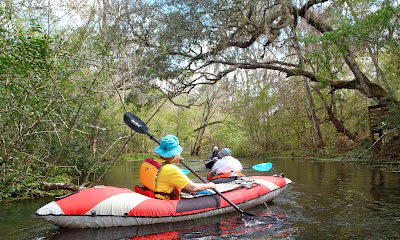So we headed off down the river, paddling.....
The turtle subdivision.
Paddling.
More river and more paddling.
More paddling.
Quiet fisherman enjoying the river. (Watching wild kayaking women paddle past....)
More river, more paddling but we made it back to Nan's by 6 pm and they saved some dinner and more importantly the pies for us. What are good friends for?
After our Alachua visit, Carol headed over to visit her sister and Sandy headed off to meet up with her sister and more kayaking around the Rainbow River. Liz, Sarah and I headed north to south Georgia. There is clear evidence of spring in Georgia. In the songs of the birds and the trees and bushes around us.

From Georgia, Liz and I headed over to visit the site of the Andersonville prison. There were volunteers at the site re-enacting scenes from the era.
The prison was cleared grass-less land surrounded by a stockade. The prisoners were left to themselves within the stockade. To find their own protection from the elements. To find their own water. To manage their own waste. It was said that you could smell the prison from ten miles away. Most prisoners did not have any tenting or coverage from the sun or rain.
The stockade was manned 24 hours a day and each shift was 8 hours. The guards only job was to shot anyone that tries to cross the dead zone. What happened on the rest of the grounds were never responded to.....
A section of stockade has been rebuilt and demonstrated the "dead" zone and the watch towers.
Other sites on the grounds.
These grounds held over 30,000 prisoners.
The stream was the source of water. It quickly became unhealthy to drink as the hospital and other support buildings outside the prison were upstream and their waste washed down and through. The small section of stockade that shows in the picture is a section that that has been rebuilt to show the main gate.
There were many monuments on the prison grounds and/or in the cemetery in memory of the soldiers from those states. The headstones are close together because that is how the soldiers were buried in the trenches, lined up close together, all without caskets.
We drove through the small town. It was small but the reason that the prison was built out in the middle of nowhere is because there was a train that passed through and allowed the confederate the ability to ship the prisoners from all over. Two trains a day came through and let off the prisoners, who then were marched the 1/4 mile over to those stockade gates and turned loose on the grounds.




























































